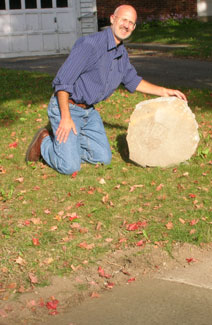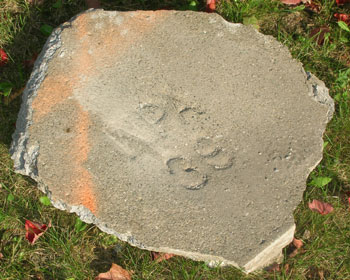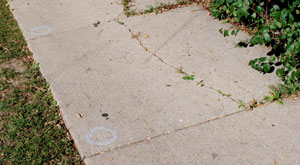Sidewalk Concrete Connects to Past
When The Chronicle spots a single chunk of concrete lying lonesome on the grass, we’ll generally swing back around for a closer look. Around Eberwhite is an area where we’d noticed sidewalk replacement in progress on a neighborhood scale over the last couple of days, but the busted up slabs had generally been stacked up and carted off. Why was this lonely chunk still sitting there? It was as if someone had set it aside as something extra special.
The stray chunk of concrete was sitting roughly between two lots, so it wasn’t completely clear who it might belong to. A guy who seemed to belong to the house on the left was already outside, so we decided to pester him about it. Dan McConnell explained first that yes, it had been saved out from the rest of the busted chunks – for the reason we already suspected: the slab remnant bore the impression “WPA39.”
The first three characters designate the Works Progress Administration (the name was tweaked in 1939 – same letters – to: Work Projects Administration). The WPA was created in 1935 by presidential order, and became the largest New Deal agency, providing employment and wages to the jobless. Among the public works projects completed by the WPA: pouring sidewalks in Ann Arbor. The number in the stamp designates the year the slab was poured by the WPA: 1939.
McConnell explained that his next-door neighbor, Jeremy Lopatin, had been the one to actually rescue the chunk when it was on its way to the the dump truck with the rest of its concrete brothers.
We bet it was not as dramatic as this, but we can imagine Lopatin running down the incline of his lawn and diving headfirst, Pete-Rose style, into the second-base-like chunk, and wrapping his arms around it: SAFE!
Who’s paying for the sidewalk replacement? In the case of the slab stamped with the effort of a 1939 WPA work crew, it’s apparently the subject of a “dispute”: Lopatin and McConnell both want to pay for it. It’s a fairly friendly dispute: “We’re not territorial,” says McConnell. In any case, it sounds like McConnell will inherit the busted WPA39 slab, which he thinks he might install as a stepping stone in a garden path.
In addition to Lopatin and McConnell, more than 10 other neighbors banded together to engage a single contractor to replace all their slabs in one go. Serge Vandervoo was the neighbor who organized them so that they could get a good price from the contractor. Plus, if everyone gets their slabs replaced at the same time, it means that the noise, dust, and general upheaval doesn’t stretch over as long a time period.
So times have obviously changed since 1939. Now it’s Ann Arbor residents, not the federal government, who pay for the sidewalk maintenance in front of property they own. When the sidewalk replacement program was first rolled out two years ago, many residents were baffled that, per city code, the city could in fact require residents to replace broken sidewalk slabs.
General outcry, frustration with lack of clarity, plus specific complaints of inaccurate marking of the slabs requiring replacement, led Ann Arbor city council in November 2007 to temporarily suspend the program. After appointing an ad hoc committee (composed of councilmembers Sabra Briere, Stephen Rapundalo, Stephen Kunselman, Margie Teall, Michael Anglin and Marcia Higgins ) to study problems and make recommendations, council restarted the program in March 2008. The suspension and restarting of the program could be described as a formality, with little interruption to the program itself, given that little sidewalk replacement activity could be expected during a span between November and March – with respect to either marking or repair.
Based on reports heard at Sunday evening caucus with city council on Sept. 21, residents along Second Street were experiencing frustration with communication failures left over from the previous year’s administration of the sidewalk repair program. This stands in contrast to the apparently smooth implementation in the Eberwhite neighborhood this year.
An Aside
The information packet about sidewalk repair that is provided to city residents addresses the question of how residents pay for their sidewalks, but not the issue of why it’s the immediately adjacent property owners who pay:
Q: Why doesn’t the City make the repairs and bill the owners?
A: When contractors perform work for the city, there are additional costs for the contractor associated with bonding, insurance, and the requirement to pay prevailing wages. Based on our Customer Service Survey, we found the average cost for a 4″ slab for homeowners in 2007 was $120. The City cost for a 4″ slab in 2007 was $170 plus administrative costs.
What individual property owner wouldn’t prefer to pay $50 less per slab? End of discussion. It’s hard to imagine an individual property owner querying a contractor for hire: “Now, can you document that you pay your workers the prevailing wage?” But if it were not the individual property owners who paid, but rather a city service paid for by property taxes, it’s unlikely that anyone would try to argue that sidewalk contractors are some sort of different category of contractor – a category from which we would not demand payment of the prevailing wage. So whether the concrete workers who are fixing our sidewalks get paid the prevailing wage has something to do with whether it’s the city or individual property owners who are responsible for sidewalk maintenance and repair.
Back to 1939
The year 1939 was an auspicious one for concrete and the WPA, not just because of the slab that got poured out in front of the house where Dan McConnell now lives. That same year, the WPA also played a small role in the construction of sidewalks for the new Ann Arbor Police Department outdoor pistol range.
The two-by-fours for sidewalk forms cost nothing, not when Mr. William Eddy loaned them from the W.P.A. The labor on the sidewalks cost nothing, not when it was contributed by police on off days, by members of local shooting clubs who were interested, and by certain citizens who had committed misdemeanors, and who preferred sunshine and sweat to spending their days in the Washtenaw County Jail. Notice the professional finish on those sidewalks? That is the fine personal touch of Sgt. Enkemann again.
That’s excerpted from Ann Arbor’s Outdoor Range, written by Alderman Arthur D. Moore, and hosted by the Ann Arbor District Library as part of the Ann Arbor Police Department Online History Exhibit.
So it’s possible that those same two-by-fours used by the WPA to form that slab out in front of McConnell’s house were also used to help construct the outdoor pistol range.
For Chronicle readers who have not yet had their sidewalks marked with the silver circles indicating required repair, the city website provides the information you’ll eventually need about sidewalk replacement. If you’ve got an interesting stamp on one of your slabs, but you’ve got no place to put a whole chunk of concrete like Dan McConnell does, why not take a photograph. Here’s an already-started collection of Ann Arbor sidewalk stamps.







Readers with sidewalks to be repaired should know be informed that additional cost reductions are possible. If several nearby houses hire the same contractor for repairs on the same day, costs of bringing in equipment and ready-mixed concrete are lower. Most contractors are willing to discount their price accordingly.
For names of a few recommended contractors see our website, DEXMIL.com in the Repairs and Renovations section.
My wife’s grandfather was known to remark that the Democrats were the party of “free beer and wider sidewalks.” This expression no doubt dated from the days of the WPA.
Wystan Stevens had a note about a stretch of Ann Arbor sidewalk that might be relevant to this discussion:
http://www.flickr.com/photos/daddyzine/2263412865/
We are trying to locate for a school project where WPA stamps on sidewalks are located in Ann Arbor. We need to take a picture and would appreicate if anyone would let us know an area where they might be.
I grew up on Olivia Street near Burns Park. I remember that there were lots of WPA sidewalk stamps in that area. A. F. Thompson, too. And Winberg & Kurtz. Kids notice these things more, being closer to the ground . . . .
The preceding should read: Wineberg & Kurtz.